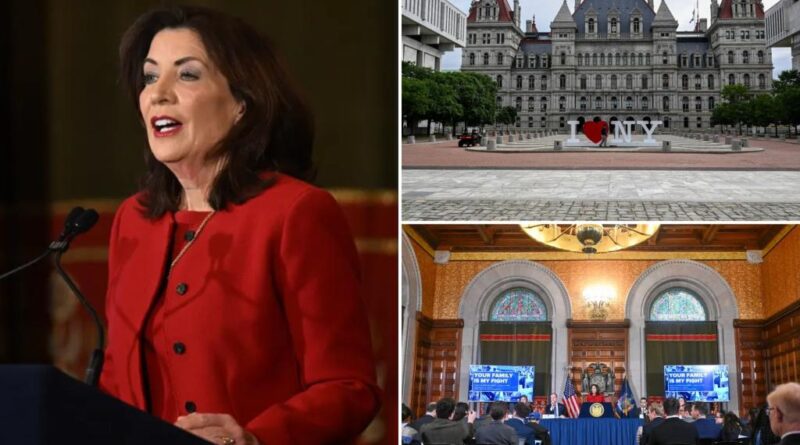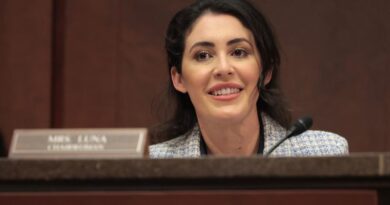Hochul’s Budget Dream Propels New York Toward a Spending Crisis

New York’s state budget is running nearly a month behind schedule, offering Albany’s Republicans a unique opportunity for influence. Will they seize it?
Governor Hochul has been engaged in budgetary tensions with legislative Democrats.
Their primary conflict revolves not around spending, but policy changes that have minimal fiscal implications: both Senate and Assembly Democrats reacted negatively to Hochul’s proposals aimed at increasing the ability to treat and confinement options for individuals with severe mental illnesses, while making it more challenging for defense attorneys to dismiss criminal cases on technicalities.
In the meantime, Republicans, who control just over a third of the seats in the Senate and slightly less in the Assembly, seem largely absent from the discussion.
The governor’s policy proposals make sense, and it’s commendable that she considers them essential for any budget negotiations.
However, this stalemate has resulted in almost no discussion regarding the quarter-trillion-dollar spending plan that Hochul and legislators are on the verge of adopting.
Hochul’s fiscal 2026 budget proposal amounted to $252 billion (including federal aid and borrowing), a significant increase from the $239 billion approved last year.
Assembly Democrats are advocating for over $256 billion; their Senate counterparts are seeking $259 billion, aiming to balance the budget through, among other methods, increasing taxes on businesses and higher-income individuals.
This is where Albany’s lethargic GOP might find an opportunity.
The rapid, inflation-busting spending increases proposed by the Democrats rely on revenue forecasts developed, with GOP input, two months prior.
The consensus projected GDP growth of 2.2% in 2025 and 2% in 2026, with wage growth and corporate profits expected to increase even more significantly.
However, those forecasts quickly became obsolete following the market disruptions caused by President Donald Trump’s tariff policies.
In late February, the Federal Reserve Bank of Atlanta estimated U.S. economic growth at an annualized rate of over 2% for the first quarter; that same model now reflects a contraction of approximately 2.5%.
As my colleague E.J. McMahon warned this month, “the worst is yet to come.”
New York heavily depends on income taxes collected from a small demographic of high earners: In 2023, the state derived half of its personal income tax revenue from just 200,000 taxpayers — under 2% of all filers.
The anticipated capital gains and bonuses that Albany hoped to tax in the forthcoming months are also likely to be significantly lower.
This indicates that the state will almost certainly have fewer resources to allocate than Democrats’ proposed budgets suggest — and neither Hochul nor legislative Democrats are acknowledging this reality.
They might plan to attribute the inevitable shortfall between revenues and expenditures to Trump and potential changes to federal tax and spending policies expected from a Republican-controlled Congress later this year.
Albany Republicans must not allow this misrepresentation to go unchallenged. They should clarify the reality and put forth their own revenue forecast — now, before the budget vote takes place.
Both Assembly and Senate Republicans have skilled fiscal teams monitoring economic indicators and daily receipts reported by state tax officials.
They must raise awareness about the state’s fiscal risks before Hochul and their spending-focused colleagues escalate expenditures to even lower sustainable levels.
There is a downside: Acknowledging that New York must rein in spending could alienate some special interests that initially contributed to its expansion.
The GOP has primarily focused on survival in recent years, often trading criticism of government spending for endorsements from public sector unions.
When Hochul proposed updating New York’s long-standing school funding formula, Albany Republicans united with the teachers’ unions to oppose her.
They attribute the MTA’s fiscal issues to fare evasion (a valid concern), yet remain silent about disproportionate union contracts leading to excessive overtime payments and inflated construction expenses.
Being irrelevant allows for inconsistencies. Albany Republicans advocate for increased spending while lamenting the tax burden.
What has this strategy achieved for them? Would New York be measurably different if GOP lawmakers had spent the last two years in Greenland instead of serving in government?
Almost unanimously, Albany Republicans hesitate to discuss the policy choices that have rendered New York’s public school system, Medicaid program, and transit system the most costly in the nation—without yielding improved outcomes for beleaguered taxpayers.
However, such discussions will become unavoidable if state revenues fall short of budget expectations.
Republicans must reclaim some credibility by sounding the alarm on the fiscal illusions surrounding Albany’s budget.
While they may be reluctant to take this opportunity, they owe it to New Yorkers to do everything possible.
Ken Girardin is a fellow at the Manhattan Institute.



